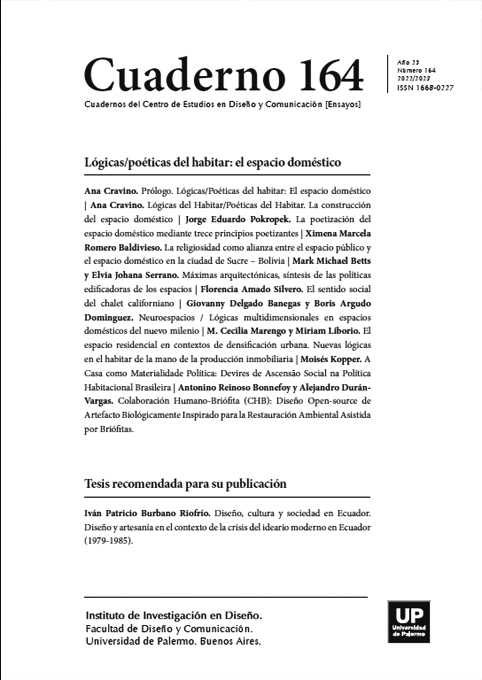A Casa como Materialidade Política: Devires de Ascensão Social na Política Habitacional Brasileira
Abstract
The article explores the ways in which the opening of new imaginative horizons is linked to the appropriation and consumption of the house among beneficiaries of public housing in Brazil.
References
Bachelard, G. (1958). The Poetics of Space: The Classic Look at How we Experience Intimate Places. Boston: Beacon Press Books.
Bessire, L. (2013). Behold the Black Caiman: A Chronicle of Ayoreo Life. Chicago; London: The University of Chicago Press.
Biehl, J., & Neiburg, F. (2021). Oikography: Ethnographies of House-ing in Critical Times. Cultural Anthropology, 36(4), 539–547.
Bourdieu, P. (2006). Argelia 60: Estructuras Económicas y Estructuras Temporales. Buenos Aires: Siglo XXI Editores Argentina.
_____ (1984). Distinction: A Social Critique of the Judgment of Taste. Cambridge: Harvard University Press.
_____ (2001). Las Estructuras Sociales de la Economía. Buenos Aires: Manantial.
Brand, S. (1994). How Buildings Learn: What Happens to them After They’re Built. Harmondsworth: Penguin.
Carsten, J., & Hugh-Jones, S. (1995). About the House: Lévi-Strauss and Beyond. Cambridge: Cambridge University Press.
Cieraad, I. (Ed.) (2006). At Home: An Anthropology of Domestic Space. Syracuse: Syracuse University Press.
Crapanzano, V. (2004). Imaginative Horizons: An Essay in Literary-Philosophical Anthropology. Chicago: University of Chicago Press.
Deleuze, G. (2006). Two Regimes of Madness: Texts and Interviews 1975-1995. Los Angeles: Semiotext(e).
Douglas, M. (1991). The Idea of a Home: A Kind of Space. Social Research, 58(1), 287–307.
Foucault, M. (1979). A Governamentalidade. In M. Foucault. Microfísica do Poder (pp. 277-293). Rio de Janeiro: Graal.
Gordillo, G. (2014). Rubble: The Aftermath of Destruction. Durham; London: Duke University Press.
Gordon Jr, C. (1996). Resenha de ‘About the House: Lévi-Strauss and Beyond.’ Mana, 2, 192–195.
Han, C. (2011). Symptoms of Another Life: Time, Possibility and Domestic Relations in Chile’s Credit Economy. Cultural Anthropology, 26(1), 7–32.
Ingold, T. (2011). Being Alive: Essays on Movement, Knowledge and Description. New York: Routledge.
_____ (2012). Trazendo as Coisas de Volta à Vida: Emaranhados criativos num mundo de materiais. Horizontes Antropológicos, 18(37), 25–44.
Kent, S. (1990). Domestic Architecture and the Use of Space. Cambridge: Cambridge University Press.
Kopper, M. (2019). House-ing Urban Kin: Family Configurations, Household Economies and Inequality in Brazil’s Public Housing. Articulo: (Journal of Urban Research), 20.
Lane, B. M. (2007). Housing and Dwelling: Perspectives on Modern Domestic Architecture. New York: Routledge.
Lévi-Strauss, C. (1986). A Noção de Casa. In: C. Lévi-Strauss. Minhas Palavras. São Paulo: Brasiliense.
Marcelin, L. H. (1999). A Linguagem da Casa entre os Negros no Recôncavo Baiano. Mana, 5(2), 31–60.
_____ (2015). Violence, Human Insecurity and the Challenge of Building Haiti: A Study of a Shantytown in Port-au-Prince, Haiti. Current Anthropology, 56(2).
Miller, D. (2001). Home Possessions: Material Culture Behind Closed Doors. New York: Routledge, 2001.
_____ (2009). The Comfort of Things. Cambridge: Polity Press.
_____ (ed.). (2005). Materiality. Durham; London: Duke University Press.
Navaro-Yashin, Y. (2012). The Make-Believe Space: Affective Geography in a Postwar Polity. Durham; London: Duke University Press.
Oliver, P. (2007). Dwellings: The Vernacular House Worldwide. Phaidon Press.
Petryna, A. (2018). Wildfires at the Edges of Science: Horizoning Work amid Runaway Change. Cultural Anthropology, 33(4), 570–595.
Rapoport, A. (1969). House Form and Culture. Hoboken: Prentice Hall.
Salata, A. (2012). A Nova Classe Média Brasileira: Contribuição para um Debate Politico. Rio de Janeiro: Observatório das Metrópoles.
Sigmund, F. (2003). The Uncanny. London: Penguin Books.
Souza, J. (2009). A Ralé Brasileira: Quem é e Como Vive. Belo Horizonte: Editora UFMG.
_____ (2010). Os Batalhadores Brasileiros: Nova Classe Média ou Nova Classe Trabalhadora? Belo Horizonte: Editora UFMG.
Zelizer, V. (1994). The Social Meaning of Money: Pin Money, Paychecks, Poor Relief, and Other Currencies. Princeton: Princeton University Press.
Los autores/as que publiquen en esta revista ceden los derechos de autor y de publicación a "Cuadernos del Centro de Estudios de Diseño y Comunicación", Aceptando el registro de su trabajo bajo una licencia de atribución de Creative Commons, que permite a terceros utilizar lo publicado siempre que de el crédito pertinente a los autores y a esta revista.


